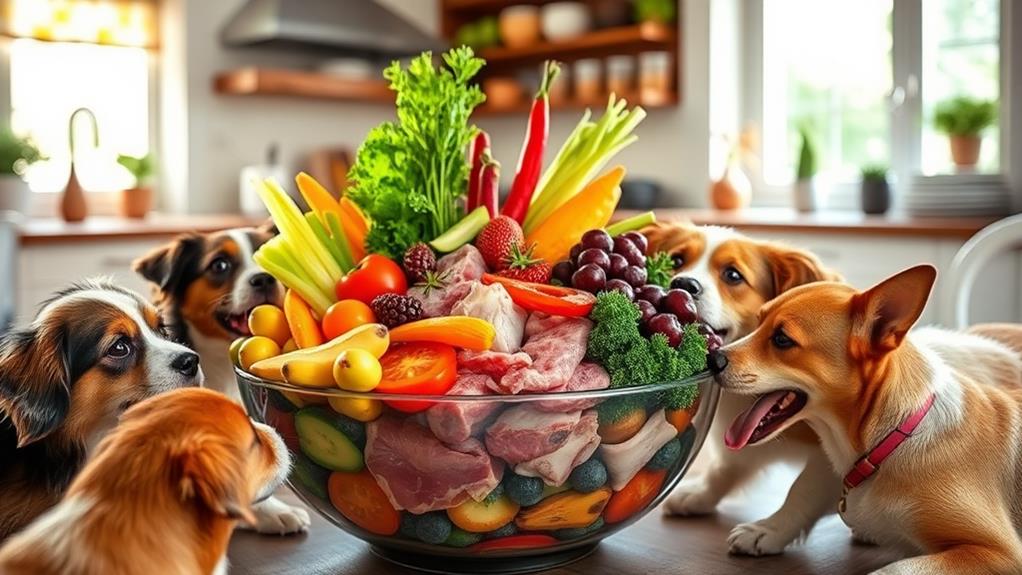Implementing a raw food diet for your dog can promote better health and dynamism. This diet consists of uncooked meats, bones, fruits, and vegetables, mimicking what dogs might eat in the wild. You'll need to guarantee your meals are balanced, including proteins, healthy fats, vitamins, and minerals. Start gradually to avoid gastrointestinal issues and watch your dog's reactions closely. Address any initial reluctance by mixing new foods with their current diet. For the best results, consult a veterinarian or pet nutritionist to tailor the diet to your dog's specific needs, and you'll find even more tips for success.
Understanding Raw Food Diets
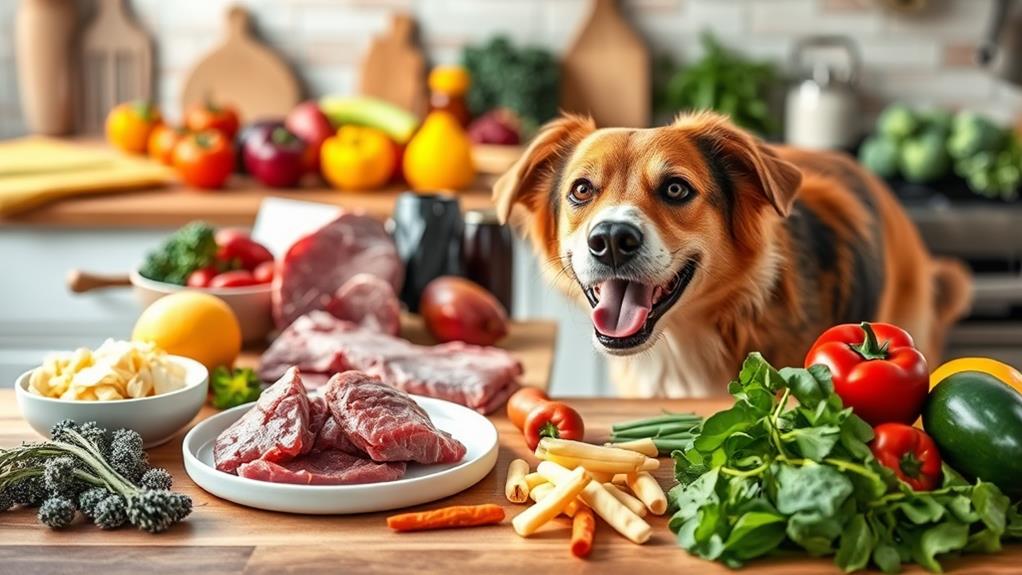
Many dog owners often explore raw food diets as a way to promote their pet's health. Understanding what a raw food diet entails is paramount before making the switch. Essentially, a raw food diet consists of uncooked meats, bones, fruits, and vegetables. This approach mimics what dogs might've eaten in the wild, focusing on a more natural form of nutrition.
You'll want to ponder the balance of nutrients when planning meals for your dog. A well-rounded raw food diet should include proteins, fats, vitamins, and minerals. It's critical to avoid relying solely on one type of food, as variety helps confirm your dog receives all necessary nutrients.
You should also be aware of potential risks, such as bacterial contamination. Handling raw food requires strict hygiene practices to prevent illness in both you and your dog. Consult with a veterinarian or a pet nutritionist to develop a safe and effective meal plan tailored to your dog's specific needs. With the right knowledge and preparation, you can make an informed decision about whether a raw food diet is the right fit for your furry friend.
Benefits of Raw Feeding
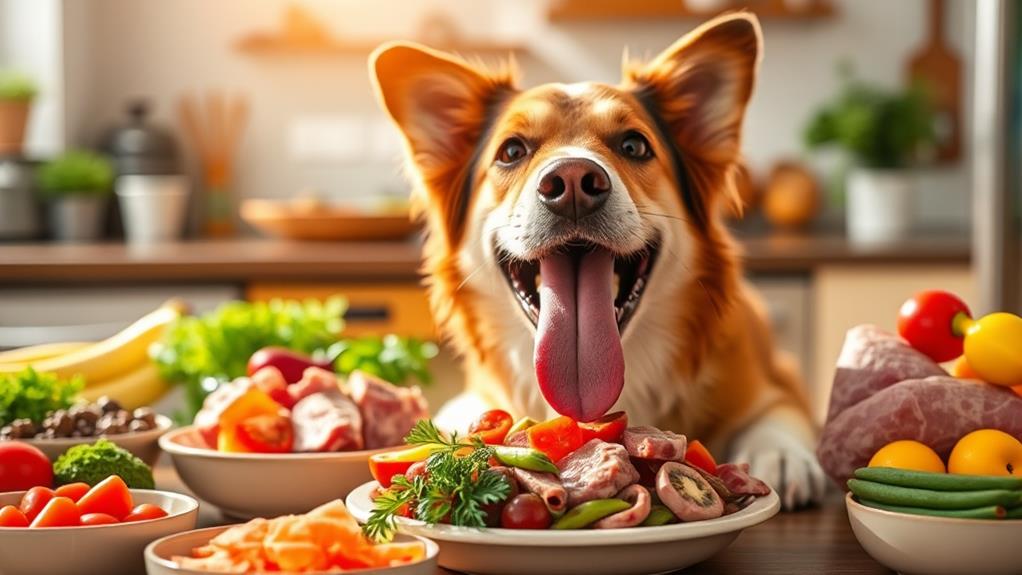
The benefits of raw feeding can be significant for your dog's overall health and well-being. When you switch to a raw diet, you may notice improvements in your dog's coat, leading to a shinier and healthier appearance. This diet often includes natural fats, which can enhance skin health and reduce allergy symptoms.
Additionally, raw feeding can promote healthier teeth and gums. The natural chewing action required to consume raw bones helps prevent plaque buildup and tartar formation. You might also see a decrease in bad breath, making those close cuddles more enjoyable.
Another advantage is improved digestion. Many dogs thrive on a raw diet, experiencing fewer digestive issues like gas or bloating. You might also find that your dog's energy levels increase, as raw food provides a nutrient-dense source of energy.
Lastly, raw feeding can lead to a more balanced weight. You can better manage your dog's weight by controlling portion sizes and ensuring they get the right nutrients. Overall, embracing a raw food diet can lead to a happier, healthier dog, allowing you both to enjoy a more vibrant life together.
Essential Nutrients for Dogs
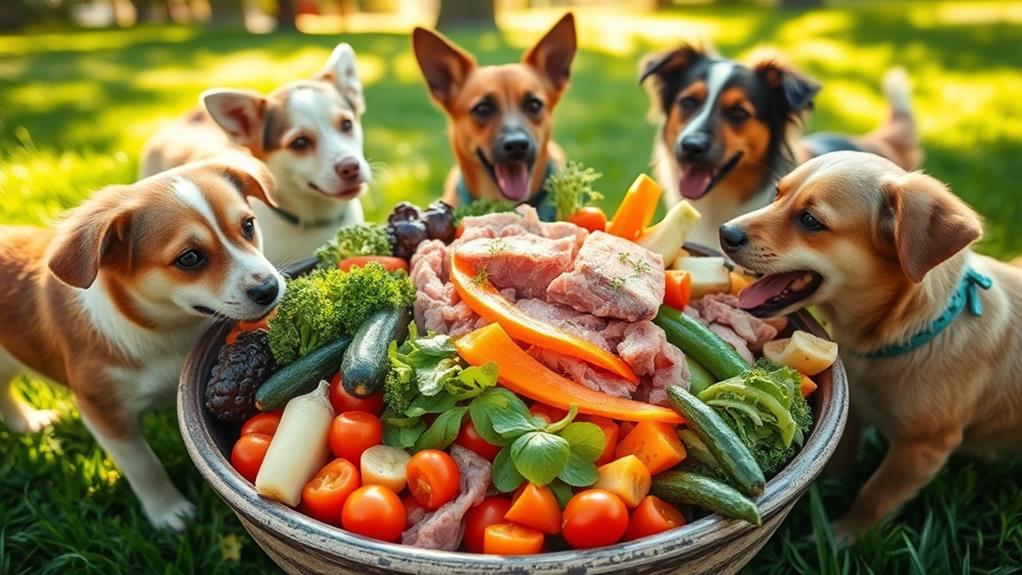
While enjoying the benefits of a raw food diet, it's important to understand the specific nutrients your dog needs for ideal health. A balanced raw diet should include proteins, fats, vitamins, and minerals.
Proteins are indispensable for muscle development and overall growth. Raw meats, fish, and organ meats are excellent sources. Don't forget about healthy fats, which provide energy and maintain skin and coat health. Incorporating fish oil can boost omega-3 fatty acids, promoting a shiny coat and reducing inflammation.
Vitamins and minerals play pivotal roles in various bodily functions. Leafy greens, sweet potatoes, and carrots can supply essential vitamins A, C, and K. Calcium is another critical mineral, essential for strong bones. You can get calcium from ground eggshells or raw meaty bones.
Additionally, dogs need fiber for digestive health. Incorporate fruits and veggies like apples or pumpkin to support their gut. Always consult your vet before making significant changes to your dog's diet to guarantee you're meeting all their nutritional needs. With careful planning, you can create a raw food diet that supports your dog's health and vigor.
Transitioning to Raw Food
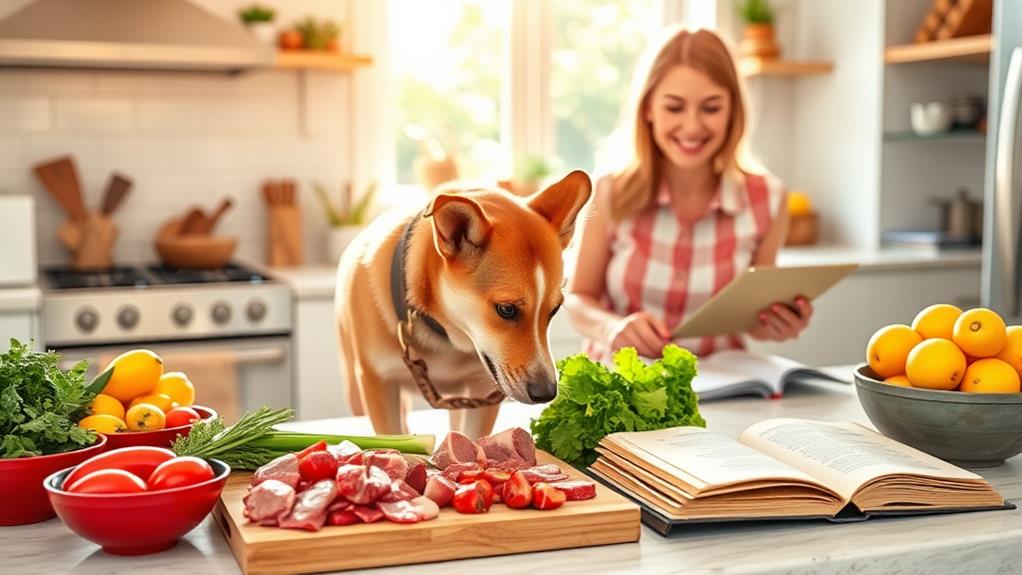
Shifting to a raw food diet can be an exciting journey for both you and your dog. To start, gradually introduce raw foods to your dog's current diet. This method minimizes gastrointestinal upset and allows their system to adapt. You might begin by replacing a portion of their kibble with raw meat or vegetables, increasing the raw portion over a week or two.
Pay attention to your dog's reactions during this switch. Watch for any signs of discomfort or changes in behavior. It's important to maintain a balance of protein, fats, and carbohydrates, so ensure you're providing a variety of proteins like chicken, beef, and fish, along with appropriate fruits and vegetables.
Consult with your veterinarian or a pet nutritionist to formulate a balanced diet that meets your dog's specific needs. They can help you understand the right proportions and necessary supplements. As your dog adjusts, you may notice improvements in their energy levels, coat condition, and overall health. Embrace this process as a way to bond with your dog while promoting a healthier lifestyle. Enjoy the journey!
Common Challenges and Solutions

Many dog owners face common challenges when moving to a raw food diet, but understanding these hurdles can make the process smoother. One major challenge is the initial reluctance of your dog to try new foods. To tackle this, you can gradually mix raw food with their current diet, slowly increasing the raw portion until they adapt.
Another issue is sourcing high-quality ingredients. It's imperative to find reliable suppliers for fresh meats, fruits, and vegetables. Check local farmers' markets or reputable online stores specializing in pet food. Planning ahead and bulk buying can also save you time and money.
You might worry about balancing nutrients in your dog's diet. While this concern is valid, using pre-packaged raw meals can simplify the process. These meals are often formulated to meet nutritional guidelines, reducing your stress.
Lastly, some owners may feel overwhelmed by the preparation involved in raw feeding. To simplify things, you can set aside a specific day each week for meal prep. This way, you'll have everything ready for the week ahead, making it more manageable. With these solutions in mind, you can confidently navigate the shift to a raw food diet for your furry friend.
Tips for Balanced Meals
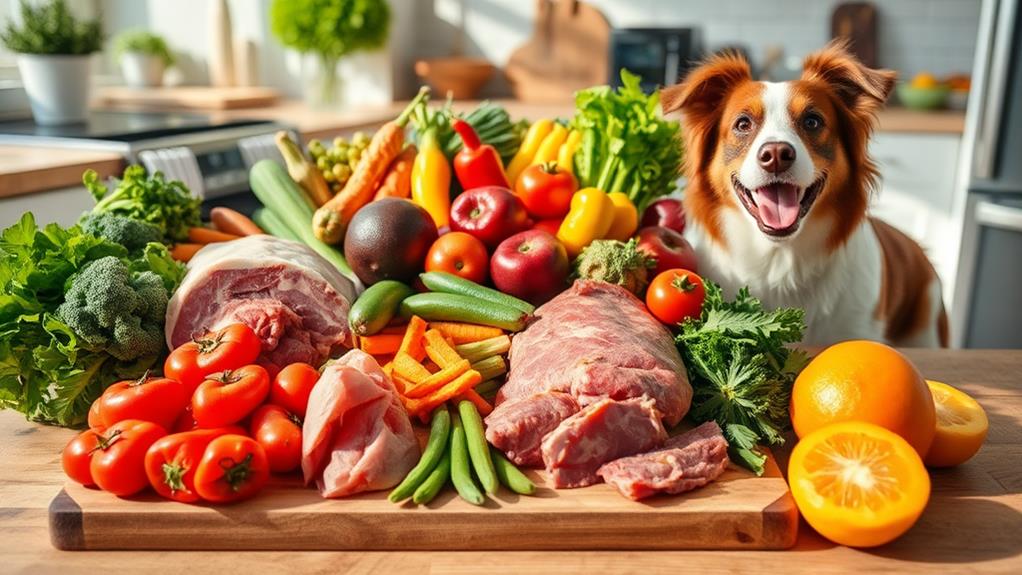
Balancing your dog's meals on a raw food diet is essential for their health and well-being. To achieve this, start by including a variety of protein sources like chicken, beef, and fish. This diversity guarantees your dog gets a wide range of essential amino acids. Aim for about 70% meat, 20% vegetables, and 10% supplements such as bones or organ meats.
Next, incorporate a mix of vegetables, like carrots, spinach, and sweet potatoes. These provide crucial vitamins and minerals that help boost your dog's immune system. However, remember to chop or puree them to aid digestion.
Don't forget about healthy fats! Adding sources like fish oil or flaxseed can help maintain your dog's skin and coat health.
Also, consider including probiotics to support gut health. Options like plain yogurt or fermented vegetables can be beneficial.
Regularly consult your veterinarian or a pet nutritionist to confirm your dog's diet meets their specific needs. They can guide you on the right portion sizes and any necessary adjustments. By following these tips, you can create balanced, nutritious meals that keep your dog happy and healthy.
Frequently Asked Questions
Can Raw Food Diets Help With My Dog's Allergies?
Raw food diets might help with your dog's allergies by eliminating common allergens found in processed foods. You'll notice improvements in their skin and overall health, but consult your vet before making any changes.
Are There Specific Breeds That Shouldn't Have a Raw Diet?
"Don't count your chickens before they hatch." Some breeds, like those with sensitive digestive systems or certain health issues, might not thrive on a raw diet. Always consult your vet before making dietary changes for your dog.
How Do I Store Raw Food Safely?
To store raw food safely, you should keep it in airtight containers in the fridge or freezer. Label the containers with dates, and always thaw frozen food in the refrigerator to prevent bacterial growth.
Is a Raw Diet Suitable for Puppies?
A raw diet can be suitable for puppies if done correctly. You'll need to guarantee it's balanced and safe, providing all necessary nutrients. Consulting a vet can help you make the best choices for your pup.
Can I Mix Raw Food With Kibble?
Yes, you can mix raw food with kibble, but it's important to guarantee proper balance and avoid digestive issues. Start slowly, monitor your dog's response, and adjust portions accordingly for best health.
Conclusion
By embracing a raw food diet for your dog, you're not just changing their meals; you're opening the door to a vibrant, healthier life. Think of it as planting a garden—nurturing the right ingredients allows for growth and vitality. As you shift, stay patient and attentive to your dog's needs. With the right balance and commitment, you'll cultivate a nourishing relationship that flourishes, ensuring your furry friend thrives on their journey to ideal health.

